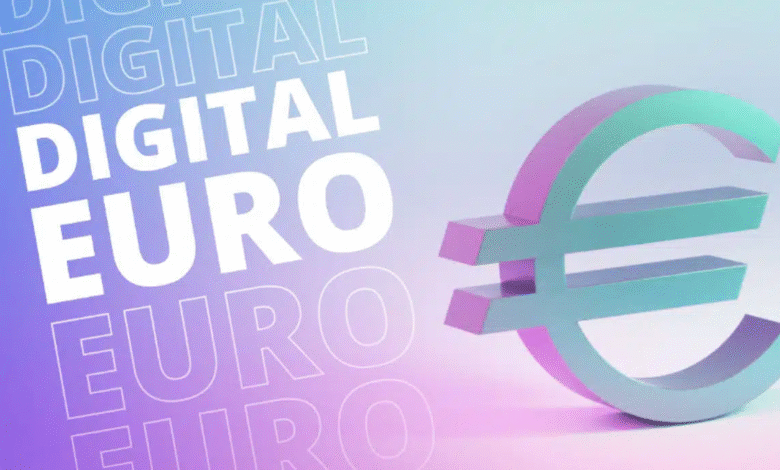Digital Euro: EU Race to Compete with Stablecoins

The digital euro is set to revolutionize the way transactions are conducted within the European Union, as officials expedite plans in response to the United States’ recent stablecoin regulations. The enactment of a law governing the $288 billion stablecoin market has raised alarms about the competitiveness of a European Union digital currency. With the European Central Bank (ECB) exploring the potential use of public blockchain technology, such as Ethereum, the digital euro could become a pivotal player in the global financial landscape. This move aims not only to modernize payment systems but also to ensure that the euro remains a relevant and dominant currency amidst increasing crypto adoption. As discussions continue on various technological frameworks, including both centralized and decentralized approaches, the urgency to implement a digital euro has never been greater.
The concept of a European digital currency, often referred to as the digital euro, encompasses a range of innovative financial solutions aimed at enhancing the region’s monetary framework. Amidst the backdrop of recent developments in stablecoin regulations across the Atlantic, there is heightened dialogue concerning the necessity and functionality of a central bank digital currency (CBDC) within the EU. As the European Central Bank (ECB) scrutinizes potential applications of blockchain technology, the implications of crypto adoption on traditional finance systems become increasingly significant. The digital euro represents not only a technological advancement but also a strategic maneuver to uphold the euro’s standing in the global market. The conversations surrounding this digital initiative highlight the critical need for the EU to adapt to the rapidly evolving landscape of digital finance.
The Need for a Digital Euro Amid Global Changes
As the financial landscape evolves, European officials are rapidly advancing plans for a digital euro. The passage of stablecoin regulations in the U.S. has sparked concerns about the competitiveness of Europe’s economic standing. The U.S. regulation of its massive $288 billion stablecoin market not only raises the stakes for how digital currencies are perceived but also highlights the necessity for the EU to fortify its own digital currency initiatives. A digital euro could provide a robust alternative that enhances the euro’s global positioning, ensuring that Europe remains relevant in the digital finance space.
The motivations driving the ECB’s interest in the digital euro are multiple. Firstly, there’s a clear awareness of the declining usage of physical cash and the need for central bank-backed digital payment alternatives. Secondly, the rising adoption of cryptocurrencies and stablecoins necessitates a proactive approach from the ECB. To this end, the European Central Bank has been thoroughly researching various frameworks to create a digital euro that aligns with the needs of modern consumers while serving as a stable medium of exchange in a digital economy.
Exploring Blockchain Technology for a Digital Euro
In the quest for a digital euro, the role of blockchain technology cannot be understated. The ECB is considering various blockchain platforms, such as Ethereum and Solana, to harness their strengths, aiming to utilize a public blockchain as a foundation for the digital euro. This choice reflects a growing trend among digital currencies towards decentralized, transparent methodologies, significantly improving security and trust among users while facilitating crypto adoption across the EU.
Utilizing a public blockchain could also pave the way for more efficient transaction processes and lower costs compared to traditional methods. Furthermore, integrating blockchain technology enhances the potential for interoperability between the digital euro and other digital currencies, a key factor as the EU evaluates stablecoin regulations. Implementing such cutting-edge technologies ensures the digital euro not only competes effectively on a global stage but also stands out in an evolving economic landscape.
How EU Digital Currency Influences Stability and Security
The introduction of a digital euro is not just about following trends; it is fundamentally about enhancing the stability and security of the European monetary system. By providing a state-backed digital currency option, the ECB aims to counter the volatility often associated with cryptocurrencies and stablecoins. The digital euro could serve as a stabilizing force, supporting the existing financial infrastructure while fostering confidence among consumers and businesses alike in digital transactions.
Moreover, the emphasis on regulatory frameworks surrounding the digital euro will play a critical role in its security. The insights gained from observing the U.S. stablecoin regulations will inform EU policy, potentially leading to a well-defined governance structure that addresses risks associated with crypto adoption. This foresight will not only reassure citizens but will also position the EU as a responsible leader in the digitization of finance, setting a benchmark for other regions to follow.
Regulatory Considerations for the Digital Euro
As the EU embarks on creating a digital euro, regulatory considerations take center stage. The introduction of a comprehensive regulatory framework is essential to ensure that the digital euro operates within a secure and reliable ecosystem. Learning from the recent stablecoin regulations enacted in the U.S., EU officials are keen on developing robust guidelines that address market risks, consumer protection, and cross-border transactions. This strategic regulatory approach aims to foster a landscape where the digital euro can thrive while balancing innovation with safety.
Furthermore, the relationship between the digital euro and existing cryptocurrencies has implications for regulatory practices. Establishing clear regulations for stablecoins within the EU corridor will create a more predictable environment for innovation. By leveraging these regulations, European authorities can ensure that the digital euro remains competitive without sacrificing regulatory rigor, thus promoting an environment conducive to crypto adoption while positioning the ECB as a forward-thinking central bank.
The Role of the ECB in Digital Currency Innovation
The European Central Bank has been at the forefront of investigating the potential deployment of a digital euro, which reflects its commitment to enhancing monetary policy in a rapidly digitizing world. As cash usage declines, the ECB recognizes the urgency in providing innovative payment solutions that meet the needs of a tech-driven society. With its extensive research, the ECB continues to explore various technological frameworks suitable for the digital euro, aiming to position the euro competitively against the dollar and other major currencies.
In this innovative environment, the ECB’s proactive approach could influence other central banks to consider similar initiatives, further catalyzing the digital currency movement globally. The ECB aims to utilize lessons learned from existing blockchain technologies, ensuring that a digital euro is secure, efficient, and sustainable. As Europe navigates through these advancements, the ECB’s role as a guiding force cannot be understated in shaping the future of digital finance.
Consumer Perspectives on the Digital Euro
Understanding consumer sentiments towards the digital euro is critical for its successful adoption. As the ECB moves closer to launching this digital currency, it is essential to gauge how potential users perceive the benefits and drawbacks of transitioning towards a cashless society. Many consumers are increasingly comfortable with digital transactions, especially amidst the rise of e-commerce and mobile payments; however, concerns regarding security, privacy, and the role of government oversight remain prevalent.
To address these concerns, the ECB must prioritize transparency in its communications regarding the digital euro’s functioning and the safeguards in place to protect users. By providing clear information about how the digital euro works, its advantages over traditional currencies, and measures to secure transactions, the ECB can enhance public confidence. Ensuring a positive user experience will ultimately be crucial for fostering widespread acceptance and participation among Europeans.
Potential Economic Impacts of the Digital Euro
The introduction of a digital euro could have far-reaching economic implications for the EU. By offering a central bank-backed digital currency, the ECB aims to drive economic efficiency and lower transaction costs for businesses and consumers alike. The potential to facilitate instantaneous payments and seamless cross-border transactions could significantly enhance the value of the euro, making it a preferred choice for international trade as well.
However, the transition to a digital euro also comes with challenges. The ECB must carefully monitor how this shift could impact the existing banking system and financial stability. Additionally, issues related to affordability, accessibility, and technological readiness among EU citizens must be addressed to ensure that the economic benefits of the digital euro are fully realized. By navigating these complexities, the ECB can maximize the positive economic impacts of this innovative initiative.
Digital Euro: Enhancing Competition within the EU
The digital euro aims to enhance competition within the EU financial ecosystem, especially in light of the recent developments in the U.S. regarding stablecoin regulations. By providing a central bank digital currency, the ECB seeks to strengthen the euro’s competitiveness on a global scale, thereby ensuring it maintains its relevance as an alternative to dominant dollar-denominated digital assets. In doing so, the ECB not only fortifies the euro’s position within Europe but also opens up opportunities for EU stakeholders to better integrate into the global economy.
Moreover, the digital euro could empower European consumers by offering them more payment options while supporting local businesses in scaling their services. As competition intensifies, it will likely promote innovation among financial service providers, ultimately benefiting consumers through enhanced products and services. Therefore, the introduction of a digital euro is not just a response to external pressures but a strategic move to uplift and invigorate the EU’s economic framework.
Future Prospects for the Digital Euro
Looking ahead, the future of the digital euro appears promising as the ECB continues its exploratory efforts. Despite the challenges involved in launching a new digital currency, the sustained interest from EU officials and stakeholders underscores the importance of the project. With the ongoing advancements in blockchain and digital technology, the digital euro could become integral to a more efficient economic environment that embraces innovation while promoting inclusiveness.
To ensure its success, the ECB will need to engage continuously with the public and private sectors to develop practical solutions that align with consumers’ needs and concerns. Building a coalition of support around the digital euro—from politicians to technologists—will be crucial in facilitating a successful rollout. As trends towards digitization remain strong, the ECB’s efforts in this area will likely play a pivotal role in shaping the future of the European financial landscape.
Frequently Asked Questions
What is the digital euro and why is the European Central Bank exploring it?
The digital euro is a proposed EU digital currency backed by the European Central Bank (ECB) designed to facilitate cashless transactions and provide a secure payment option as cash use declines. The ECB is exploring the digital euro to ensure competitiveness against dollar-denominated stablecoins and to enhance the European payment landscape.
How does the stablecoin regulation in the U.S. impact the digital euro initiative?
The recent stablecoin regulations enacted by the U.S. Congress have raised concerns within the European Union regarding the competitiveness of the digital euro. EU officials believe that without a robust digital euro, the dominance of dollar-backed stablecoins could undermine the euro’s position in global markets.
Will the digital euro utilize blockchain technology?
Yes, the digital euro may utilize blockchain technology. The European Central Bank is considering various technological solutions for the digital euro, including the possibility of adopting a public blockchain like Ethereum or Solana, instead of a private blockchain, to enhance transparency and accessibility.
How does the digital euro relate to crypto adoption in Europe?
The digital euro represents a key step in accelerating crypto adoption in Europe. By providing a central bank-backed digital currency, the ECB aims to legitimize digital transactions and promote the integration of digital currencies within the traditional financial system, potentially increasing user confidence in crypto.
What are the potential benefits of the EU digital currency, the digital euro?
The digital euro could offer several benefits, including safer and faster transaction methods, enhanced financial inclusion, and a competitive edge against international digital currencies. It aims to ensure that Europe retains control over its monetary policy while adapting to the evolving global digital economy.
When is the digital euro expected to be launched?
While there is no official launch date for the digital euro, the European Central Bank is actively investigating and developing the concept. EU officials are aware of the urgency due to the rapid shifts in the global digital currency landscape, particularly with ongoing developments in the U.S. stablecoin regulations.
What challenges does the digital euro face in its development?
The digital euro faces various challenges, including technological decisions on whether to use public or private blockchain solutions, regulatory compliance, and addressing concerns about privacy and security. Additionally, competition with existing cryptocurrencies and stablecoins will play a crucial role in its acceptance.
| Key Point | Details |
|---|---|
| Speeding up plans | EU officials are accelerating the development of a digital euro. |
| Reaction to U.S. stablecoin law | The U.S. regulation of the $288 billion stablecoin market raised competitiveness concerns. |
| Discussion of blockchain options | EU is considering utilizing public blockchains like Ethereum or Solana instead of a private blockchain. |
| Goals of the digital euro | To provide a central bank-backed payment method amidst declining cash usage. |
| Concerns about digital dominance | EU fears that U.S. legislation could enhance the dominance of dollar-denominated tokens. |
| Current exploration by ECB | While several technologies are being explored, no final decision has been made regarding the digital euro. |
Summary
The digital euro is becoming increasingly critical as European Union officials expedite its development to maintain competitiveness against U.S. innovations in digital currencies. With the enactment of a stablecoin law in the United States, the need for a central bank-backed digital euro is emphasized, reinforcing the urgency for EU policymakers to adopt robust digital currency strategies.



